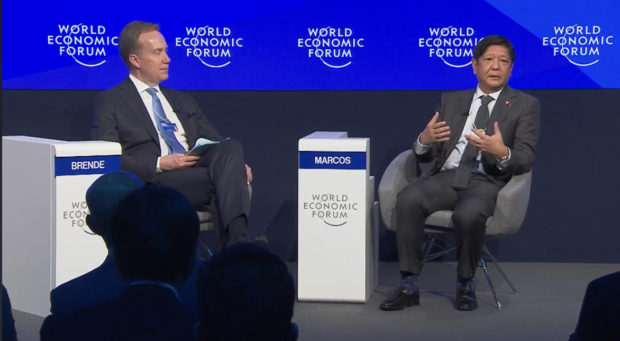
World Economic Forum president Børge Brende and President Bongbong Marcos Jr.
DAVOS – The World Economic Forum sees the Philippines as an economic outperformer in Southeast Asia, a rarity at this time when most parts of the world are heading into recession.
“It is incredible… I think now, Philippines is the fastest growing of the Asean (Association of Southeast Asian Nations) countries,” World Economic Forum (WEF) president Børge Brende said on Wednesday during his one-on-one dialogue with President Ferdinand Marcos Jr. at the WEF annual meeting.
The Philippine government expects full-year 2022 gross domestic product (GDP) growth rate to exceed its target range of 6.5 to 7.5 percent, while Marcos has expressed optimism that growth this 2023 would remain robust at 7 percent.
Marcos noted that the country was currently enjoying a demographic sweet spot, referring to the period where an optimal number of the country’s population would be of working age and have few dependents.
“The reason that I’m so confident about that is because we have a very, very good workforce in the Philippines. We have the youngest workforce in Asia. You might be surprised to know, to learn that the average age of Filipino worker is 23 and a half years old. So that is a huge [source of] demographic dividend,” Marcos said.
“But demographic dividend is not paid out just as a matter of course. You have to develop. You have to develop now. Some of the concepts that we keep hearing about is upskilling and reskilling and that we have concentrated on,” he said.
The President also took pride in the country’s pool of “well-trained, sophisticated” and tech-savvy English-speaking workforce.
Marcos also told Brende that his administration was concentrating on micro, small and medium enterprises that provide the backbone of the economy.
“And I think that’s where the growth is coming from,” Marcos said, adding he was also closely watching jobs data.
“My theory, my belief, and I think I’m right is that, as long as the unemployment rate stays low, then the recessionary forces are something that we can resist. So that’s why I think — that gives a good foundation for growth,” he said.
When asked by Brende about the stumbling blocks that the Philippines may encounter moving forward, the President said the main obstacles for the country would be infrastructure, quality of education, research and development (R&D), and bureaucratic red tape, among other things. But he said the country would be able to overcome these challenges.
To surmount present challenges, the President said his administration was developing the country’s infrastructure by promoting public-private partnerships (PPPs) and reforming the bureaucracy especially through digitalization.